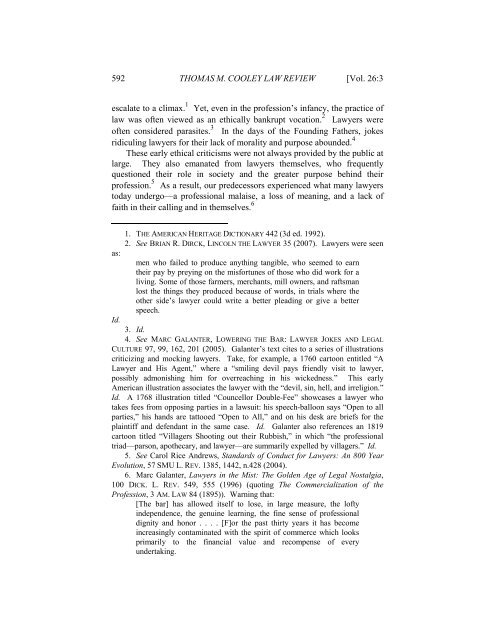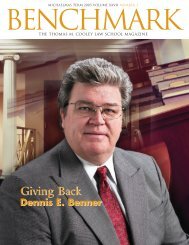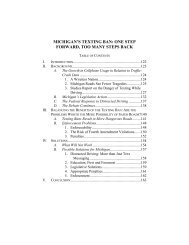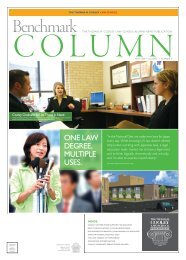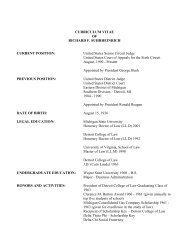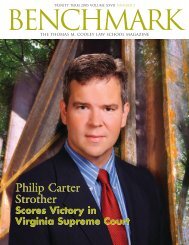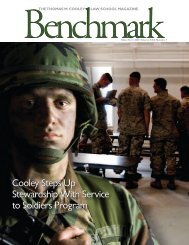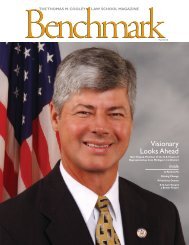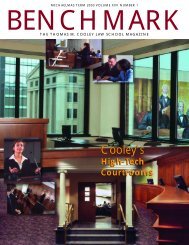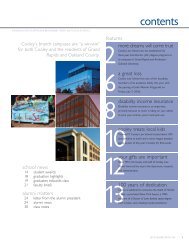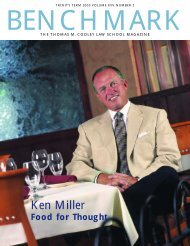Beyond The Model Rules - Thomas M. Cooley Law School
Beyond The Model Rules - Thomas M. Cooley Law School
Beyond The Model Rules - Thomas M. Cooley Law School
You also want an ePaper? Increase the reach of your titles
YUMPU automatically turns print PDFs into web optimized ePapers that Google loves.
592 THOMAS M. COOLEY LAW REVIEW [Vol. 26:3escalate to a climax. 1 Yet, even in the profession’s infancy, the practice oflaw was often viewed as an ethically bankrupt vocation. 2 <strong>Law</strong>yers wereoften considered parasites. 3 In the days of the Founding Fathers, jokesridiculing lawyers for their lack of morality and purpose abounded. 4<strong>The</strong>se early ethical criticisms were not always provided by the public atlarge. <strong>The</strong>y also emanated from lawyers themselves, who frequentlyquestioned their role in society and the greater purpose behind theirprofession. 5 As a result, our predecessors experienced what many lawyerstoday undergo—a professional malaise, a loss of meaning, and a lack offaith in their calling and in themselves. 6as:1. THE AMERICAN HERITAGE DICTIONARY 442 (3d ed. 1992).2. See BRIAN R. DIRCK, LINCOLN THE LAWYER 35 (2007). <strong>Law</strong>yers were seenmen who failed to produce anything tangible, who seemed to earntheir pay by preying on the misfortunes of those who did work for aliving. Some of those farmers, merchants, mill owners, and raftsmanlost the things they produced because of words, in trials where theother side’s lawyer could write a better pleading or give a betterspeech.Id.3. Id.4. See MARC GALANTER, LOWERING THE BAR: LAWYER JOKES AND LEGALCULTURE 97, 99, 162, 201 (2005). Galanter’s text cites to a series of illustrationscriticizing and mocking lawyers. Take, for example, a 1760 cartoon entitled “A<strong>Law</strong>yer and His Agent,” where a “smiling devil pays friendly visit to lawyer,possibly admonishing him for overreaching in his wickedness.” This earlyAmerican illustration associates the lawyer with the “devil, sin, hell, and irreligion.”Id. A 1768 illustration titled “Councellor Double-Fee” showcases a lawyer whotakes fees from opposing parties in a lawsuit: his speech-balloon says “Open to allparties,” his hands are tattooed “Open to All,” and on his desk are briefs for theplaintiff and defendant in the same case. Id. Galanter also references an 1819cartoon titled “Villagers Shooting out their Rubbish,” in which “the professionaltriad—parson, apothecary, and lawyer—are summarily expelled by villagers.” Id.5. See Carol Rice Andrews, Standards of Conduct for <strong>Law</strong>yers: An 800 YearEvolution, 57 SMU L. REV. 1385, 1442, n.428 (2004).6. Marc Galanter, <strong>Law</strong>yers in the Mist: <strong>The</strong> Golden Age of Legal Nostalgia,100 DICK. L. REV. 549, 555 (1996) (quoting <strong>The</strong> Commercialization of theProfession, 3 AM. LAW 84 (1895)). Warning that:[<strong>The</strong> bar] has allowed itself to lose, in large measure, the loftyindependence, the genuine learning, the fine sense of professionaldignity and honor . . . . [F]or the past thirty years it has becomeincreasingly contaminated with the spirit of commerce which looksprimarily to the financial value and recompense of everyundertaking.


